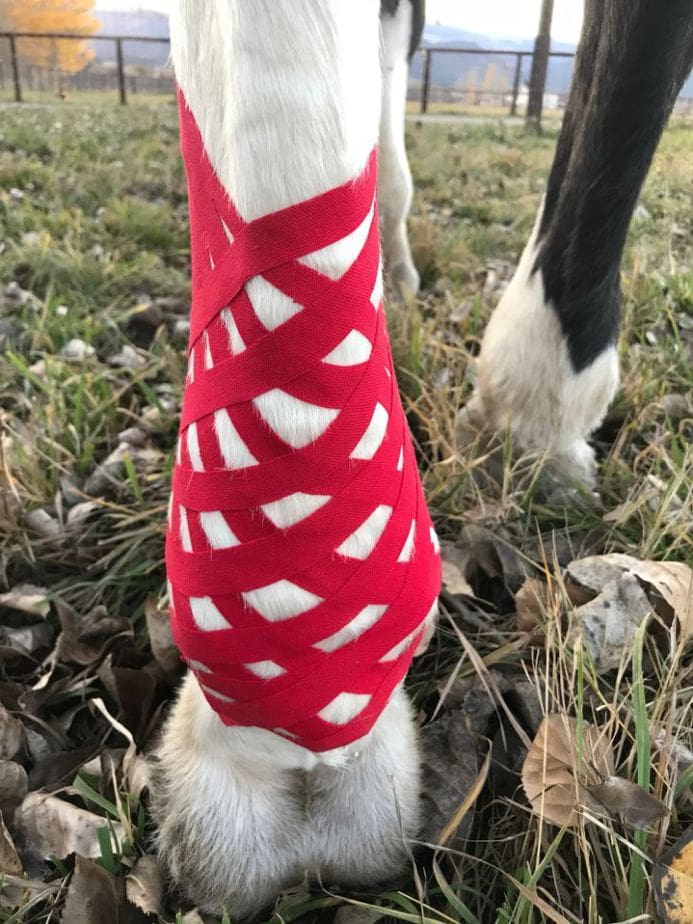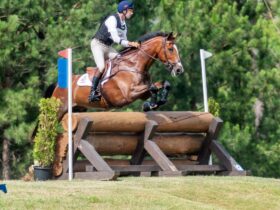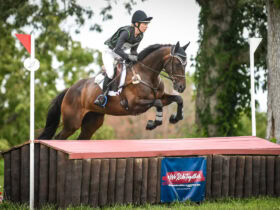—Carrie Washburn, Performance Equine – Integrated Therapies
Many of us over the years have experienced, or at least seen, kinesiology tape in action. It’s colorful, sporty, bright, and it just plain looks cool. Athletes across the board, from high school to Olympic, have been using it with great success. Heck, Kerri Walsh wore it back in 2008 and won a beach volleyball Olympic gold medal! It must work, right?
Work it does! But, have you ever thought of using it on your equine athlete?
Our equine partners are athletes, and as such, can benefit immensely from kinesiology tape. From edema to sore muscles and tight fascia, kinesiology tape can get your equine partner to the head of the class. It’s non-invasive, drug-free, and USEF/FEI approved* making it the perfect modality to help your equine athlete feel their best at home and away. *Horses are not allowed to compete with it on but can use it before and after competition at USEF/FEI events.
Dr. Kenzo Kase of Japan invented kinesiology tape during the 1970s while searching for a way to help the body facilitate its natural healing process. Its popularity increased when Walsh wore it in the 2008 Summer Olympics. Unlike other athletic tape, kinesiology tape is elastic, breathable, and water-resistant. Meaning it can add support without restricting movement, and with its elastic properties, it can reduce swelling, increase blood flow, and help with lymphatic drainage.
The tape itself is commonly made from cotton, spandex, and adhesive. Different brands offer different percentages of stretch and “stickiness” of the adhesive. For use on horses, the human water-resistant kind tends to work best. Most brands offer a water-resistant tape with the extra sticky adhesive. Some brands do carry an “equine” line, too. Whether you choose to use the human version or equine-specific tape, your horse will benefit.

Full longissimus dorsi gluteal biceps femoris taping with a lumbosacral junction
decompression star

Edema taping placed on the upper front leg lower carpus to help reduce swelling
The science behind kinesiology tape is actually quite simple. With its elastic properties, in its most basic use, it decompresses the skin from the soft tissue underneath. With this decompression, a lifting effect is created. In turn, the convolutions created in the skin (wrinkles that increase surface area) open up the natural gliding action between skin, muscle, and fascia. The thin sheet of connective tissue that encloses, separates, and stabilizes muscles is “fascia.” This decompressed space also creates less pressure on nerve endings, lymphatic vessels, and blood vessels, allowing for reduced or completely negated pain, increased lymphatic drainage, and increased blood flow and circulation.
To help get an idea of the effect, picture a hair tie pulled tight. If you keep pulling and keep tension on it, eventually it will break. Obviously, not a good outcome when we are talking about human or equine fascia and muscle. Think of it like this: the outside sheath of the elastic (your horse’s fascia) is tighter than the rubber band on the inside (your horse’s muscle). Because of the tight outside creating restriction, the inside cannot stretch any further. Once you release your pull on the outside, the inside relaxes and stretches as well. The relationship between fascia and muscle is similar in concept and kinesiology tape releases that pull. Imagine how much better your equine partner could feel with that kind of release.
There is also a belief that having the tape applied stimulates mechanoreceptors within the skin that play a part in movement awareness. Therapists call this proprioception. These proprioceptors provide information to the brain along the equine nervous system. Although we aren’t applying the tape directly to the skin for our equine partners, the effectiveness is still the same. When applied to their hair, the same lifting effect is created and decompression happens. The mechanoreceptors in the skin are stimulated, and movement awareness is created.
Of course, there is a technique to applying kinesiology tape. It is not a simple slap-on and voila your horse is magically better. To create the magic, the tape needs to be applied correctly. It is all about the stretch! Too much is not good because the tape will not hold for long and too little limits its effectiveness altogether. With that, about 2” on each end will have zero stretch. This allows the tape to stick to your horse consistently. The alternative would be too much stress on the ends with the tape losing contact. Another important factor is whether to apply the tape to a flexed or relaxed muscle. For most equine applications, I prefer a stretched muscle. This helps create the all-important convolutions in the skin when the muscle is released out of the stretched position.
The direction of the stretch also plays an important role, especially when working on foals with limb deformities or adult horses needing help with flight patterns and gate issues. Studies have shown that proper application of kinesiology tape can assist with correcting crooked legs in foals and adult horses with flight patterns or mild limb deformities. Some argue that interfering with the natural flight pattern in an established, adult horse’s limb is risky. Once an adult horse has established its natural way of moving, it may not be the best thing for the horse to try to correct that issue. My opinion on this varies on a case-by-case basis and I would work heavily with the horse’s veterinarian to determine the best course of action.

Hind end decompression star and taping treating the gluteal muscles and the biceps femoris

Lumbosacral junction decompression star with gluteal taping
A basic example is how kinesiology tape can influence gate abnormalities through increased proprioception. For instance, if a horse is dragging their hind hooves, applying tape down the dorsal line of the hind legs can stimulate mechanoreceptors in the skin, which in turn, stimulates them to lift their legs higher and step farther under themselves. This can help “retrain” their brain and strengthen their muscles to help correct a gate abnormality.
When applied in a unique lattice wave pattern, kinesiology tape can greatly help with swelling and edema. This makes it an ideal modality for minor leg injuries and body swelling from minor kicks or abrasions; it should however, never be applied directly over an open wound or to any infected area. Because of its ability to increase circulation, applying to an active infection could cause the infection to spread. On the other hand, applying an edema taping to minor leg swelling, such as wind puffs, can have fabulous results because of its ability to increase blood circulation and flow.
The length of time the tape can/should be applied varies by use. Ideally, I prefer to leave it on for about 48 hours, but when taping highly mobile and flexible areas such as the neck, I aim for 8-12 hour. The more the better, if it will stay attached! Ideally, the horse should not be ridden the first 12 hours the tape is applied, but otherwise there is no concern about saddling directly over the tape as long as it is still attached and smooth. No waiting period is necessary once the tape is removed.

Edema taping placed on a lower hind leg to help reduce swelling
How can “Magic Tape” help your equine athlete?
- Improve blood flow and circulation
- Increase lymphatic circulation
- Reduce inflammation
- Improve gate abnormalities
- Reduce or completely negated pain
- Promote healing
- Relieve muscle stiffness, soreness, and fatigue
- Increase the effects of bodywork
Often, I hear riders expressing that their horse does not feel quite right; not lame, just not fully like themselves. This is where an Equine Bodyworker or Physio Therapist who specializes in Equine Kinesiology Taping can help. Typically, after hearing a rider or trainer explain what they’re feeling, and a full body examination, they will be able to apply the tape to relieve that discomfort.
Most times, when a horse isn’t feeling “quite right,” riders and trainers are forgetting that their horses are truly equine athletes, and as such, require help to relieve body aches and pains from training and showing just like we do. It is very commonplace for equine athletes to be sore bilaterally on their hind end including their gluteal muscles, biceps femoris, and lumbosacral junction. These areas are often the cause of the “not quite right” feeling but are unfortunately overlooked daily. If this area is determined to be the source of the problem, once tape is applied and the horse is rested overnight, most riders will experience “WOW” on their next ride!
Because it is USEF/FEI approved, kinesiology tape is wonderful to use to treat minor issues that may arise while you’re competing. While, in most instances you cannot use it while directly competing, you can use KINESIOLOGY tape before, during warmup, and after showing. I’ve seen firsthand its ability to help a horse feel their best in a competition situation, often going from “not quite right” to “WOW” in one overnight application.
Kinesiology tape can also help during transport and traveling. Our equine partners often travel long hours in straight or small box stalls to get to their destination. This can leave our equine athletes with sore and tired legs, backs, and hind ends. Adding a longissimus dorsi taping along the back onto the gluteal muscle before loading on to the transport can help reduce or totally mitigate that stress.
Keep in mind, our equine partners are athletes no matter what their level. They work hard so we can reach our goals and achieve things that we thought weren’t possible. Kinesiology tape is a fantastic, natural, non-invasive way for us to help them feel their best!
(As always, kinesiology taping is not a substitute for veterinary care. If your horse if experiencing lameness or soreness please consult your veterinarian.)
Carrie Washburn is an equine physiotherapist certified in equine sports massage and equine kinesiology taping and educated in cold laser therapy and Pulsed Electromagnetic Field (PEMF) therapy. As founder of Performance Equine – Integrated Therapies in Carbondale, Colorado, Carrie has worked on some of the country’s top dressage, reining, and show jumping horses. She also competes one of her own horses, Eros, throughout Colorado, Arizona, Utah, New Mexico, Wyoming, California, and Kentucky and has competed at USDF Region 5 Championships and the US Dressage Finals.



















SOCIAL